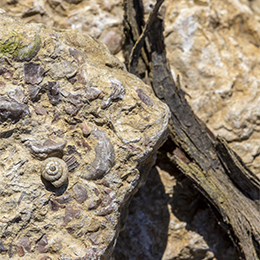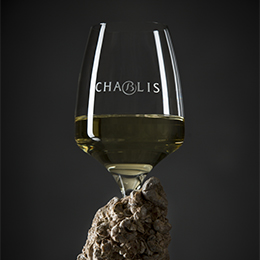Around 250 million years ago, an emerald lagoon covered what is now Bourgogne. As a result, the subsoil contains marine marl and limestone deposits. The roots of the vines go deep into this unique geological legacy, drawing from it the finesse, depth and minerality that are so characteristic of Bourgogne appellations.
You can find Comblanchien limestone all over the world.
Although Bourgogne folk are used to finding it mainly around Nuits-Saint-Georges, Comblanchien limestone – better known as Comblanchien marble – exports well. It is appreciated for its high density and can be found in many prestigious buildings such as the Louvre Museum, where it was used to construct the entrance wall and the staircase of the great pyramid; the refectory in the Abbey of Cîteaux; the Pont de Tolbiac in Paris; and the facings on the façade and some of the staircases in the Taipei 101 tower in Taiwan.

Use your imagination to go back between 200-250 million years. There are no vines here. And for good reason – what we know today as Bourgogne was, back then, beneath a warm and shallow sea, like a tropical lagoon.
Over the next 170 million years, the sand below became packed with the remains of algae and shellfish. Comblanchien limestone is part of the rock formed by this marine sediment.
It is extremely dense and outcrops are mainly found on the Côte de Nuits.
Now jump forward to just 30 million years ago when the formation of the Alps created a shockwave that generated folds, hollows and humps. The Bressan rift, a major sedimentary basin between the Jura and the Massif Central, collapsed. It created the relief that is the Côte and the Hautes Côtes as we know them today.
The numerous geological movements during the Tertiary era allowed mankind to create a patchwork of thousands of plots. Clay, limestone and marl terrains were thus combined into the celebrated Climats.
The grape varietals most suited to Bourgogne draw their character from and flourish on this exceptional soil:
• Pinot Noir flourishes on marl soils that are more yielding and porous, that tend towards limestone and which offer good drainage. It will produce light and sophisticated or powerful and full-bodied wines, depending on the proportion of limestone, stone content and clay on the plot where it grows.
• Chardonnay prefers more clayey marly limestone soils from which it can develop sophisticated, elegant aromas in the future wine. The clay helps produce breadth in the mouth, characteristic of the Bourgogne region’s great white wines.

The subsoil of Bourgogne is always offering surprises and reveals its secrets little by little. Only a few decades ago, researchers discovered it contains dietary elements and microorganisms. Their role is essential in the development of a wine’s aromatic qualities. Just like sunshine hours, photosynthesis, temperature and rainfall, they help define the characteristics of the region’s Appellations d’Origine Contrôlée (AOCs).
The winegrowers of Bourgogne listen to their land, nurture their vines and take care of the soil. In order to preserve the unique geological characteristics of each plot, they work in a way that respects the plant and its environment, limiting the use of phytosanitary products as much as possible.
Year-round, the winegrowers follow the plants’ growth cycle, maintaining their plots. Find out what they do, month by month.